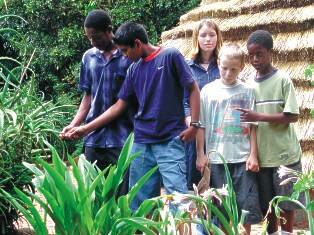HighlIghts
Chairman 's Report
Gardens
Research
Education
Biodiversity Policy&Planning
Marketing
HR & Finance
Financial Statements
Natal National Botanical Garden
|
 The Natal NBG once again participated in the annual Natal Clivia Show, winning most of the awards, including that for best plant on show. One of the most popular attractions at the Natal NBG is the Look, Listen, Feel, Smell Garden and with a donation from the Hilton Round Table, it was extended to include a Secret Garden. Devoted to the lighter side of horticulture, this new display features a children's fantasy garden, a 'botanical zoo' containing plants with names such as elephant's foot and bobbejaanstert, and a 'poetry corner' designed to inspire people to put their thoughts to paper while sitting in secluded poetry nooks. The existing medicinal plant garden was also redeveloped and extended to form a new Useful Garden, displaying plants used for all kinds of purposes, from making beer and weaving mats to curing headaches. The traditional Zulu hut which was part of the original display, was re-thatched and re-oriented to form the focal point of this new garden. An innovative new interpretation label design developed by Garden staff was used to describe the traditional uses of the plants on display. Despite the lack of a sponsor, three music concerts were held during the year where a concert entrance fee was charged without objection from the public. The Natal NBG is also involved in assisting HIV/AIDS sufferers through the Children in Distress Network (CINDI). The Garden was approached by CINDI to provide propagative material for easily grown indigenous species that are used to treat some of the secondary skin infections commonly experienced by HIV/AIDS patients. After careful consideration, Garden staff agreed to supply material of Bulbine fructescens and Carpobrotus edulis, which are used successfully to treat skin infections. They are non-toxic, easy to grow and need no preparation for use. Plants are supplied to the AIDS Wellness Centre in Pietermaritzburg where they are given to visitors to take home, plant and use. The response has been overwhelming so far and many bags of plants have been delivered to the Centre.
|